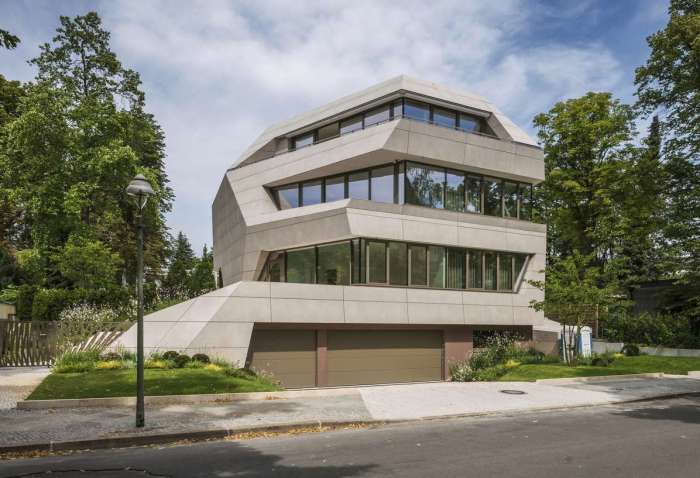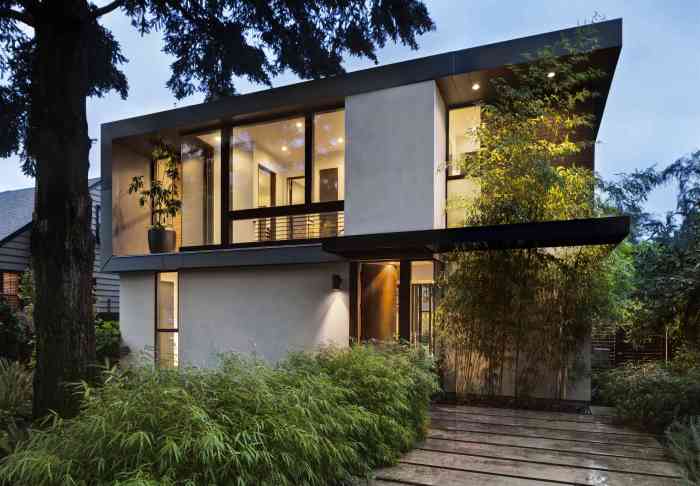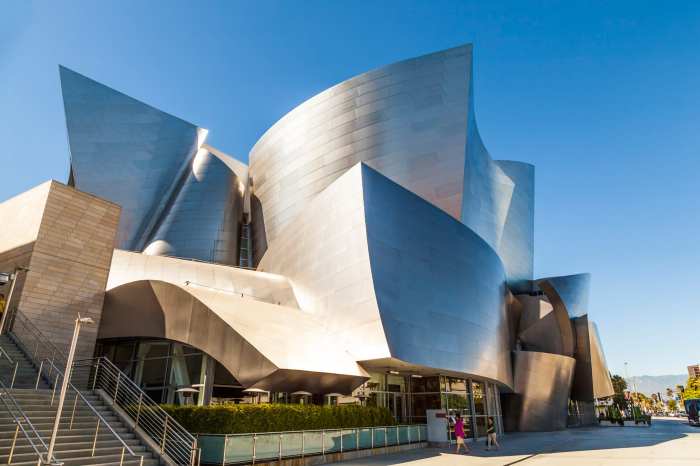Exploring Contemporary Architecture: A Modern Perspective
Contemporary architecture sets the stage for this enthralling narrative, offering readers a glimpse into a story that is rich in detail and brimming with originality. From innovative materials to iconic landmarks, this overview delves into the essence of contemporary architectural design.
Definition of Contemporary Architecture
Contemporary architecture refers to the current architectural trends and styles that are being practiced today. It is a reflection of the present time and incorporates innovative design concepts while also drawing inspiration from various sources.
Key Characteristics of Contemporary Architecture
- Use of sustainable and eco-friendly materials
- Emphasis on functionality and minimalism
- Integration of technology in design
- Exploration of unconventional shapes and forms
- Open floor plans and natural light
Differences from Other Architectural Styles
- Modern architecture focuses on clean lines and simplicity, while contemporary architecture is more experimental and diverse.
- Traditional architecture tends to follow historical styles and techniques, whereas contemporary architecture breaks away from these conventions.
- Postmodern architecture incorporates elements of past styles in a playful and ironic manner, while contemporary architecture looks towards the future with fresh ideas.
Key Influences on Contemporary Architecture

In the realm of contemporary architecture, several key influences play a significant role in shaping the direction of design and construction. These influences range from technological advancements to a growing emphasis on sustainability, all of which contribute to the evolution of architectural practices.
Technological Advancements
Technological advancements have revolutionized contemporary architecture, providing architects with new tools and techniques to push the boundaries of design. The use of computer-aided design (CAD) software allows for intricate and complex structures to be visualized and constructed with precision. Additionally, advancements in building materials and construction methods have enabled architects to create innovative and sustainable designs that were previously unimaginable.
Sustainability in Architecture
Sustainability has become a central focus in contemporary architectural practices, with architects increasingly incorporating environmentally-friendly design principles into their projects. From utilizing renewable energy sources to implementing passive design strategies, architects are finding creative ways to reduce the environmental impact of buildings.
The integration of sustainable practices not only benefits the planet but also enhances the quality of life for building occupants.
Materials and Construction Techniques in Contemporary Architecture
In contemporary architecture, the choice of materials and construction techniques plays a crucial role in shaping the design of buildings. Innovative materials and sustainable construction practices are now at the forefront of architectural innovation, driven by advancements in technology.
Innovative Materials in Contemporary Architecture
One of the key aspects of contemporary architecture is the use of innovative materials that were not traditionally used in construction. Materials such as carbon fiber, ETFE (Ethylene Tetrafluoroethylene), and translucent concrete have revolutionized the way buildings are designed and constructed.
These materials offer unique properties such as flexibility, transparency, and sustainability, allowing architects to push the boundaries of design.
Sustainable Construction Techniques
Sustainability is a major focus in contemporary architecture, leading to the adoption of eco-friendly construction techniques. Green roofs, solar panels, rainwater harvesting systems, and passive design strategies are just a few examples of sustainable practices employed in modern buildings. These techniques not only reduce the environmental impact of construction but also contribute to energy efficiency and overall building performance.
Technology Influence on Material Choices
Advancements in technology have greatly influenced the selection of materials in contemporary architecture. Computer-aided design (CAD) software, parametric modeling, and 3D printing have enabled architects to explore new possibilities in material use. For example, the development of smart materials that can adapt to environmental conditions or change their properties has opened up a whole new realm of possibilities in architectural design.
Iconic Contemporary Architectural Masterpieces

Iconic contemporary architectural masterpieces around the world showcase the innovative and groundbreaking designs that have redefined modern architecture. These buildings not only serve as functional structures but also stand as symbols of creativity, vision, and cultural significance
The Guggenheim Museum Bilbao, Spain
The Guggenheim Museum Bilbao, designed by renowned architect Frank Gehry, is a striking example of contemporary architecture. Its unique titanium-clad exterior and organic form have made it an iconic landmark in Bilbao. The museum's design revolutionized architecture by blending art, architecture, and technology seamlessly, creating a dynamic space that attracts visitors from around the globe.
The Sydney Opera House, Australia
Designed by Danish architect Jørn Utzon, the Sydney Opera House is a UNESCO World Heritage Site and a symbol of Australia's cultural identity. Its iconic sail-like shells and stunning waterfront location make it one of the most recognizable buildings in the world.
The Sydney Opera House has had a profound impact on the cultural landscape of Australia and has become a global architectural icon.
The Burj Khalifa, Dubai
The Burj Khalifa, designed by Skidmore, Owings & Merrill, is the tallest building in the world and a marvel of modern engineering and design. Its sleek, futuristic silhouette and innovative construction techniques have set new standards for skyscraper design. The Burj Khalifa has become a symbol of Dubai's rapid development and ambition, reshaping the city's skyline and attracting visitors from all over the world.
Challenges and Criticisms in Contemporary Architecture

Contemporary architects face various challenges in their design process, ranging from sustainability issues to budget constraints and technological advancements. These challenges often require innovative solutions and a deep understanding of the evolving needs of society.
Environmental Sustainability
One of the primary challenges in contemporary architecture is ensuring environmental sustainability. With the increasing focus on climate change and resource depletion, architects are under pressure to design buildings that are energy-efficient, utilize sustainable materials, and reduce their carbon footprint.
This requires a thorough understanding of green building practices and incorporating renewable energy sources into the design.
Budget Constraints and Economic Factors
Another significant challenge faced by contemporary architects is working within budget constraints and economic factors. Clients often have limited resources for construction projects, which can impact the scale and scope of architectural designs. Architects must find creative ways to balance aesthetic appeal with cost-effective solutions without compromising the quality of the final product.
Technological Advancements
The rapid pace of technological advancements presents both opportunities and challenges for contemporary architects. Integrating cutting-edge technologies such as 3D printing, augmented reality, and Building Information Modeling (BIM) into the design process can enhance efficiency and precision. However, architects must continuously adapt to new tools and software to stay competitive in the industry.
Criticisms of Contemporary Architectural Trends
Contemporary architectural trends have faced criticism for prioritizing aesthetics over functionality and sustainability. Some critics argue that iconic buildings often lack practicality and fail to address the needs of the community. Additionally, the emphasis on avant-garde designs can lead to a disconnect between architecture and the surrounding urban environment.
Addressing Urbanization and Social Issues
Contemporary architecture plays a crucial role in addressing urbanization and social issues by creating spaces that foster community engagement and sustainable living. Architects are increasingly focusing on designing mixed-use developments, green spaces, and affordable housing to accommodate the growing urban population.
By integrating social responsibility and inclusivity into their designs, architects can contribute to creating more equitable and livable cities.
Conclusion
In conclusion, contemporary architecture embodies a fusion of creativity, technology, and sustainability, shaping the landscapes of our cities and societies. As we navigate through challenges and criticisms, the impact of these architectural masterpieces on our urban environments remains profound and thought-provoking.
Key Questions Answered
What defines contemporary architecture?
Contemporary architecture encompasses modern design trends that focus on innovation, sustainability, and technology integration.
How does technology influence contemporary architectural practices?
Technology influences contemporary architecture through advanced construction methods, digital design tools, and smart building solutions.
What are some challenges faced by contemporary architects?
Contemporary architects often face challenges related to balancing aesthetics with functionality, meeting sustainability goals, and addressing urbanization issues.




